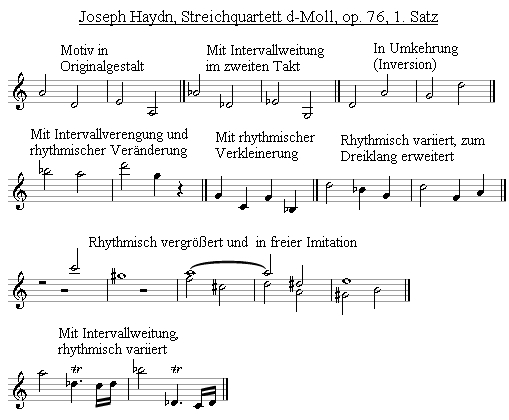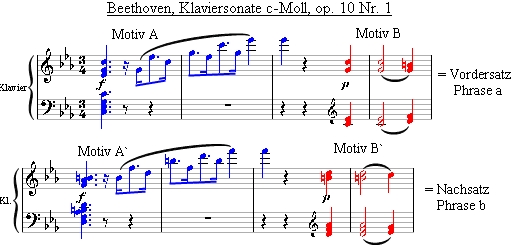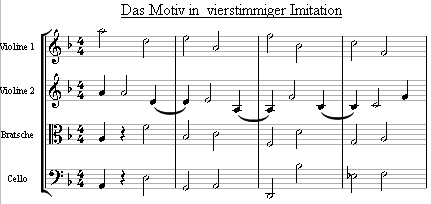Motif (music)
In the theory of musical forms , the term motif (from Latin movere = to move; late Latin : motivus = to move) describes the smallest meaningful musical unit. It is a typical, prominent and memorable structure that is important as a characteristic sequence of tones for a composition or one of its forms and can also be perceived by the listener.
As the smallest component (of a musical idea), a motif can consist of just two tones, for example as an ascending fourth (hunting motif) or a descending minor third ( cuckoo motif). The delimitation of the motif is usually made audible by phrasing cuts , pauses and other caesuras.
A motif has the power to become independent: it can be repeated in the further course of the composition, shifted to different tone levels, changed or combined with other motifs. Therefore, in contrast to an accompanying figure or ornament, the motif is to be seen as the melodic nucleus of a musical development in a work.
In the classical period , the motif becomes a central component of the composition due to its diverse processing. Haydn developed this method of composition decisively and thus became one of the founders of “classical” music. Ludwig van Beethoven used the transformation and combination of motifs as an elementary form-forming element. Almost all of the composers who followed him, such as Schubert , Brahms , Tchaikovsky , Bruckner and Mahler, continue this tradition. In dodecaphony , too , motivic-thematic work plays a central role.
Delimitation of the term
In musicology , the concept of the motif is used for the individual analysis of musical works or working methods of individual composers . The exact delimitation of a motif from other musical units - figure , phrase , period (movement) and theme - is often difficult for the listener of a work and is not clearly defined in music theory either.
As a concise melodic element, a motif is usually clearly audible and distinguishable from other tone sequences of a composition. Transitions, accompaniments, decorations and style-dependent phrases have a smaller individual shape and are therefore less characteristic. They often have a purely technical function, i.e. they clarify the harmony in a melodic way, often as a chord break or as an accompaniment to a higher-level melody. They can therefore be classified under the concept of the figure. A typical example are the so-called "Alberti basses": broken triads that appear frequently in Mozart's piano sonatas . Such figures do not constitute independent compositional material that is equal to the melody. They are therefore considered less essential when considering a piece musically.
The next larger melodic unit of meaning after the motif is the phrase . This is usually delimited by pauses that give a singer the opportunity to take a breath. It consists of several, often two melodically combined motifs. If the individual motif is longer, it can coincide with a phrase.
Phrases, in turn, combine to form so-called periods (movements) : musical "sentences" which in turn combine to form a "theme" and formally subdivide this into - in classical music mostly symmetrical - measure units, while a single motif is not congruent with a measure duration have to be.
A theme denotes a larger musical unit of meaning that consists of several motifs, phrases and periods. The topic is often introduced at the beginning of a piece (in a piece cycle: a "sentence") and then forms something like the most important "statement" of a piece, to which other parts refer. Therefore, motif, phrase, period and topic relate to each other in much the same way as "word", "sub-clause", "sentence" and "stanza" in the bound language of a poem. The theme is thus the more comprehensive term, but which derives its content from the motifs and periods.
The musical analysis sometimes breaks down motifs again into partial motifs and thus actually contradicts their definition as the “smallest musical unit of meaning”. The term group of motifs refers to a collection of similar or derived motifs. In musical analysis , alphanumeric characters are often used, but not always consistently , to identify a motif hierarchy (for example: A, B, A1, A ', A2, B2, Aa1, Bb2, etc.).
Appearances of the subject
One can distinguish between primarily melodic , rhythmic and harmonic motifs. Of course, the three components can also be equivalent, such as in the above musical example by Beethoven op. 10 no. 1 or in the sonata “Pathetique” op. 13, bars 1–2.
The opening bars of Beethoven's 5th Symphony or the rhythmic motif of death in Schubert's song “Death and the Maiden” , for example, are primarily rhythmic . Here is an example of melodic and harmonic motifs:
In addition, music theory distinguishes so-called continuation motifs from development motifs . Both are based on the linear melody . In baroque music , the spinning motif is widespread, which rarely forms focal points and shies away from symmetry . At the initial impulse of the first figure, the melody line is usually continued without major interruptions until a new motif appears. Due to the constant stringing and linking of the melodic lines, it is often very difficult to separate the individual motifs from one another. From this follows their tendency to self-dissolve into figures or second voices, which makes them rather unsuitable for motivic-thematic work . The compositional principle of the Baroque is more geared towards “counterpoint” and polyphony (equivalent polyphony) so that melody and harmony penetrate each other.
The development motive, on the other hand, prevails in the homophonically oriented music of the Classical and Romantic periods . It delimits itself clearly, tends towards constant metric centers of gravity and towards symmetry. Its substance is retained and is therefore more suitable for processing (example: the second movement of the symphony with the bang by Joseph Haydn).
In the history of music, attempts have often been made to name motifs according to their emotional content, their movement behavior or their interval structure and to fix them to a certain expressive content . This was especially true for the baroque figure theory and affect theory , which knew over a hundred figure names based on rhetoric . Furthermore, in the program music of the 19th century, the leitmotif was combined with a level of meaning outside the music (feeling, person) as an “ idee fixe ” ( Richard Wagner , Hector Berlioz ).
The folk song was of course shaped by the motif in all epochs of music. Here are just a few of the most common motif names:
Sigh motif (Latin = suspiratio) for rising or falling, mostly cautious secondary motifs ,
Cross motif : Consisting of four tones which, if you combine the first with the fourth note and the second with the third, form a cross. (e.g .: BACH )
Cuckoo motif (descending minor third, the cuckoo actually sings very differently, but mostly about a major third),
Knock / repetition motif ("Raindrop Prelude" by Frédéric Chopin ),
Scale motif for ascending or descending diatonic or chromatic scales or scale excerpts,
Curvature motif for a curved or sinusoidal tone sequence,
Jump motif for a larger interval jump up or down,
Interval stretch motif (e.g. f'-f '' - f'-g '' - f'-a '' ...) for a tone sequence that increases the distance to the starting tone and connects the jump and the scale,
Fifth motive , Quart Motif , etc., such as motives, which are named after the prevailing interval leap: the "quint case" when the interval descends, as "Quart jump" when it rises (for example in the folk song " In marches the farmer ").
Processing options for the motif
The processing options of the motif are: repetition, variation and contrast, whereby these can also be combined with one another.
Melodic possibilities of changing the motif are:
- the decrease or increase in some or all of the intervals.
- the reversal of the direction of the intervals ( inversion ).
- playing back the entire motif ( cancer ).
Rhythmic options for changing the motif are:
- the enlargement ( augmentation ) and reduction ( diminution ) of the note values of the entire motif.
- the lengthening and shortening of individual tones.
Harmonic variations are repetitions of the motif in a changed harmonic context.
The manifold possibilities of this technique are shown by some examples from Joseph Haydn's String Quartet in D minor , opus 76, 1st movement:

![]() Audio sample line 1 and 2
Audio sample line 3
Audio sample line 1 and 2
Audio sample line 3![]()
The juxtaposition of the motif (contrast) with another, very contrasting motif can give the original motif new impulses and create tension. The motifs often merge with one another in the course of motivic-thematic work , which often results in new motifs.
The procedures mentioned were used in the period from Joseph Haydn to Gustav Mahler in the main sonata form , especially in the genres of sonata , symphony and string quartet (see example).
In the music of the Middle Ages , motivic work was also used, but was not always central. On the one hand, it was partly the intention of the music, which is characterized by the principle of varietas (Latin: colorfulness, diversity), to avoid repetitions and the formation of symmetries in the rhythmic and melodic area ( Guillaume Dufay ). On the other hand, in the chanson , for example in Gilles Binchois ' motif, themes are again quite clearly structured.
A master of motivic-thematic work was Ludwig van Beethoven , who created dramatic - dialectical sentences or even entire works from small, inconspicuous motifs . Franz Schubert's rather lyrical - modulatory approach, on the other hand, eschews the decomposition of motifs and motivic-thematic work. He uses rather variation-like playings and changing harmonic interpretations of the theme.
In romantic music , the notes of the theme are often distributed alternately between the upper, lower and middle voices, so that neither the terms homophony nor polyphony capture this spelling. Robert Schumann speaks here of the inner voice (Humoreske op. 20), a kind of imaginary melody. Rhythmic shifts and harmonic ambiguities also create a moment of “romantic veiling and enchantment”.
In the late romantic period , Anton Bruckner allowed the motif to slowly develop from a “ rudimentary core ”. Its essential intervals are presented at the beginning (3rd symphony). Beethoven already used this approach in his 9th Symphony .
The number of motives and Motivabwandlungen has - as well as the size and instrumentation of the orchestra - increased considerably, and the boundary between exposure and implementation begins to blur.
In Impressionism , motifs and motivic-thematic work partly receded in favor of harmony and sophisticated instrumentation .
Both tendencies are present in the music of the 20th century . The composers Paul Hindemith and Igor Stravinsky , who are also otherwise form-conscious, continue to pursue the motivic-thematic work, and the twelve-tone technique also provides this space ( ).
It is all the more important there because the classic relationship between the motifs and tonal harmony was abandoned as a compositional principle in favor of the horizontal 12-tone series. The example cited creates a motif reference through rhythmic grouping in three-tone groups played by different instruments in different note values (sixteenth notes, eighth notes, eighth note triplets, quarter triplets). Melodically, the reference is given by the use of the third and the interval of the minor ninth. After a pause, the piano applies this principle to the reverse of the 12-note row.
Other composers like Olivier Messiaen and Steve Reich , on the other hand, deliberately avoid the motif.
Conventional motive analysis can hardly be applied to music that is based purely on sound or noise structures ( clusters , minimal music , sound surfaces , micropolyphony , aleatoric , musique concrète ): unless the concept of the motif is expanded to include purely rhythmic, tonal ones or other structures. One component could then be the sound 'A', which always has a certain length and is played with a precisely defined dynamic when it occurs. This so-called selective music renounces traditional motivic-thematic work and propagates the "equal rights of all elements of the composition" ( Karlheinz Stockhausen ).
Historical development of the term
By Angelo Berardi 17th century the term comes motivo di cadenza for a pulse of basic votes to circuiting . Berardi also used the same expression for a melody fragment for contrapuntal formation. Jean-Jacques Rousseau understood the term motif to be the original and main compositional idea of a piece.
The first beginnings of a musical theory of motifs date back to the 18th century, when Johann Mattheson and others began to break down the melody into individual parts of the sentence. The concept of the motif was not yet common in German musicology, although the main idea of an aria was usually called motivo . The terms motif, theme and suction ghetto were used synonymously.
With Adolf Bernhard Marx (1837) the term found its way into musicology at the beginning of the 19th century. Marx saw the motif as "... germ and instinct ... a formula of two or more tones serving the musical design, from which the larger row of tones grows." He already distinguished between motif and theme. Hugo Riemann (1882) saw the motif as an always upbeat original cell, which was not undisputed. The term thematic work began to establish itself from the 19th century through Heinrich Christoph Koch (1802) and Johann Christian Lobe (1844).
The term thematic work is associated with a qualitative element of the highest compositional art. At the same time, the so-called technique is differentiated from the older contrapuntal method as the central design principle of classical music . As a consequence of the differentiation between topic and motive, the term motivic work also appears. This gives rise to the somewhat indifferent expression of motivic-thematic work
literature
- Heinrich Lemacher , Hermann Schroeder : Form theory of music . Hans Gerig Verlag, Vienna 1962, ISBN 3-87252-009-1
- Clemens Kühn: Theory of Forms in Music . Bärenreiter, Kassel 1987, ISBN 3-7618-4460-3
- Erwin Ratz: Introduction to the theory of musical forms; About formal principles in J. S. Bach's inventions and fugues and their significance for Beethoven's compositional technique . Universal Edition, Vienna 1973, ISBN 3-7024-0015-X
- Günter Altmann: Musical theory of forms . Volk u. Wissen, Berlin 1960, 1970, K. G. Sauer, Munich 1989 (licensed edition), ISBN 3-598-10873-7
- Kurt von Fischer: The relationships between form and motif in Beethoven's instrumental works . Georg Olms, Hildesheim 1972, ISBN 3-487-04294-0
- Ludwig Finscher : Joseph Haydn and his time . Laaber, Regensburg 2000, ISBN 3-921518-94-6
- Hermann Erpf : Form and Structure in Music . Schott, Mainz 1967, ISBN 3-7957-2212-8
- Egon Sarabèr: Method and Practice of Music Design . Paper plane, Clausthal-Zellerfeld 2011, ISBN 978-3-86948-171-5









